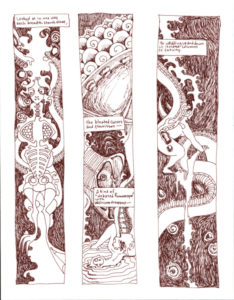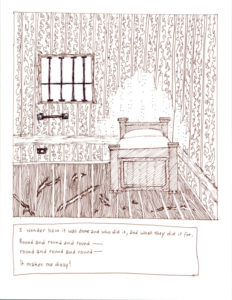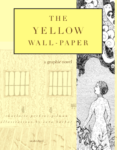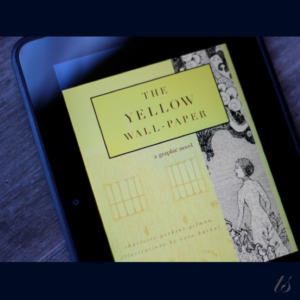Editor’s Note: Our book clubs are regularly set aside as exclusive experiences, as thanks to our Patrons, whose generosity helps us bring wisdom, kindness, and joy to the world.
Today, we hope you’ll enjoy this edition of The Yellow Wall-Paper book club, as our National Poetry Month gift to you—a piece that ordinarily would have been for patrons only.
***
In the sections we read last week we got a glimpse of Mary, who takes care of Our Lady’s baby, and a mention of John’s sister, Jennie. Other people show up in this section as well, including “mother and Nellie and the children.” We hear about Cousin Henry and Julia. Oh, and there is someone else:
The faint figure behind seemed to shake the pattern, just as if she wanted to get out.
I got up softly and went to feel and see if the paper did move.”
Who is this someone? Is she real? A ghost? A hallucination? A manifestation of Our Lady? Are we getting the story straight, or are Gilman (and Barkat, with her illustrations) telling it slant?
Tell all the truth but tell it slant –
Success in Circuit lies
Too bright for our infirm Delight
The Truth’s superb surprise
As Lightning to the Children eased
With explanation kind
The Truth must dazzle gradually
Or every man be blind –
—Emily Dickinson
After Our Lady gets up to investigate the Someone, she wakes John but doesn’t tell him about her discovery. She never does tell him.
In 1913 Charlotte Perkins Gilman wrote a piece titled Why I Wrote The Yellow Wall-Paper in The Forerunner. In it she identifies the cause of her suffering as “a severe and continuous nervous breakdown tending to melancholia.” She could have written a straightforward story about a woman going through exactly that type of breakdown, but she didn’t. Instead she wrote one that could be about a haunted house (or at least, haunted wallpaper), about a husband who could be a sociopath, about the need to write and what happens when a woman can’t do the thing that might save her.
I think the success of the story is in its circuitousness. Our Lady gets up. Our Lady lies down. Round and round the wallpaper she goes, day after day.
and I determine for the thousandth time that I will follow that pointless pattern to some sort of a conclusion. I know a little of the principle of design, and I know this thing was not arranged on any laws of radiation or alternation or repetition or symmetry or anything else I ever heard of.”

I spy bodies, snails, disembodied eyes. I like the panel that shows Our Lady’s feet on the bed, her toes somehow still playful despite her tiredness and her husband’s mysterious tonics.
Dickinson says “The Truth must dazzle gradually / Or every man be blind —.” In one panel Our Lady’s hands are over her eyes as if she were blinding herself. But she’s only adjusting her eyes so the truth can dazzle her gradually.
For this is when the “formless sort of figure” becomes “a woman stooping down and creeping about behind that pattern.” The “faint figure” is the hope Our Lady has been seeking. Only “in twilight, candlelight, lamplight, and … by moonlight,” does she begin to see the unseen. It is, as Dickinson described, “Too bright for our infirm Delight.” Lightning has struck and the only explanation for Our Lady is to study the wallpaper.
and I am determined that nobody shall find it out but myself!”
This can’t end well. Or can it?
For Discussion
1) How might you suffer if your creativity were denied you?
2) In the first section, Our Lady had a vision of what she thought would cure her. What do you think might have helped her recover?
3) What effect do the other characters have on Our Lady as they interact with her? How do these other people see the wallpaper?
We’re reading The Yellow Wall-Paper by Charlotte Perkins Gilman, illustrated by Sara Barkat together this month. We’re also considering the story using poems by Emily Dickinson as a lens. Are you reading along? Share with us in the comments your thoughts on this section of the story.
Photo by Jonathan Kos-Read, Creative Commons, via Flickr. Post by Megan Willome.
Browse more from the The Yellow Wall-Paper book club
- Perspective: The Two, The Only: Calvin and Hobbes - December 16, 2022
- Children’s Book Club: A Very Haunted Christmas - December 9, 2022
- By Heart: ‘The night is darkening round me’ by Emily Brontë - December 2, 2022





Leave a Reply